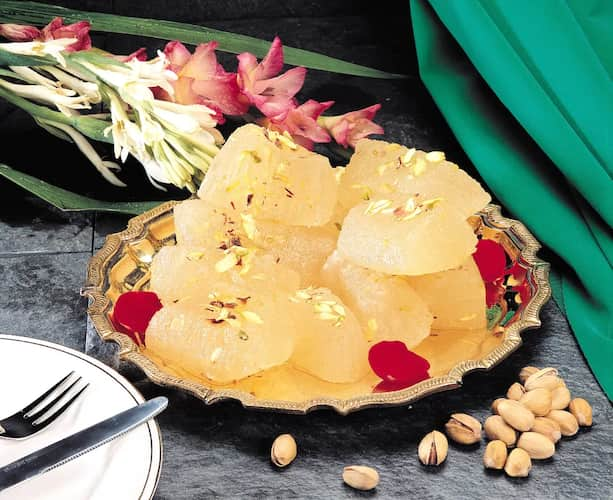The city of Agra has an incomparable masterpiece called the Taj Mahal, which is laden with precious stones like jade, onyx, and lapis lazuli. But it is also famous for Agra ka petha, the edible jewels that come in dazzling colors of green, yellow, and white.
How The Petha Was Invented
Petha goes back a long way—nearly 400 years—to when Mughal Emperor Shah Jehan was ruling. He was rumored to have sophisticated culinary taste and to have had the best chefs in his royal kitchens. According to legend, while constructing the Taj Mahal for 22 years, workers were fed roti and dal and got bored of eating the same thing. They wanted to eat something else and give their petition to the emperor.
Shah Jehan then turned to Ustad Isa, his master architect, for help, and he approached a Pir, or holy man, who received the recipe for petha during meditation. According to another legend, the emperor desired a sweet that was as pure and white as the Taj Mahal. In response to this request, the petha was created.

How Is Petha Made?
During the traditional petha preparation process, coal was burned to produce heat, resulting in organic waste that polluted the Taj Mahal's air and contributed to its unsightly appearance. As a result, to avoid polluting the Taj Mahal, many families were relocated across the Yamuna River. They were also encouraged to switch from coal to using LPG gas to make petha.
There are some of the oldest petha-making units here, where you can see how this confectionary was made. Inside dark rooms with steam billowing from huge pots, workers remove pumpkin seeds and slice them up into bite-sized pieces. Then, with the help of forks, marks are made in it, and then it is put in a sludge of white calcium hydroxide, or edible lime, for eight to ten hours.
After that, the pumpkin pieces are drained, washed, and boiled in water till they appear to be tender and translucent, then soaked in sugar syrup. The sugar syrup is flavored with saffron or rose, and after 24 hours of soaking and drying, the delicacy gets a moist and chewy texture inside, and a crisp exterior outside.
White Petha Makes The Taj Mahal Black!
The Taj Mahal is a popular destination for tourists, and Agra is home to many small manufacturers that produce the petha to satisfy their needs. Agra’s famous candy was caught up in a controversy in 2014 when the government declared an 80-kilometer area around the Taj Mahal the "Taj Trapezium Zone" and prohibited coal-fired manufacturing.
Due to the Taj Mahal's white marble becoming grimy from air pollution, the law was made to protect it. However, local petha manufacturers, who still use coal to boil sugar syrup, complained that the law harmed their businesses. They say that their way of making petha had nothing to do with the Taj Mahal turning black and that their businesses were being targeted.
There are 1500 cottage units producing petha daily in Agra. It has a long shelf life, making it an ideal sweetmeat for sale compared to other candies that spoil quickly. Approximately 700 tons of petha are sold daily.
White gourd is beneficial for a variety of health problems, including gastritis, ulcers, coughs, and asthma. The petha created in Agra today has a GI label to verify its place of origin.
Varieties Of Petha
While in Agra, you can savor petha in its traditional form as well as varieties like green paan petha (which tastes like a sweet paan), cherry petha, chocolate petha, coconut, almond, orange, pineapple, and angoori petha. You can also find innovative ones, such as the petha sandwich (khoya, cashews, and cardamom are stuffed between layers of petha) and the gulab ladoo.
Sada Petha
The sada petha is the traditional petha sold in Agra and is a must-try for anyone coming to Agra. It's crunchy on the outside and soft and juicy on the inside; it's a slice of pure heaven for anyone with a sweet tooth.
Paan Petha
Paan Petha is made with fresh ingredients such as pan powder, cashews, and gulkand and is molded to look like an actual paan. It is famous for its taste and freshness.
Kesar Angoori Petha
Agra's Kesar Angoori Petha is heaven for sweet-toothed individuals. It is yellow in color, and kesar is used in making this type of petha.
Chocolate Petha
In this type of petha, chocolate is combined with the juiciness of the petha for a combination made in heaven. Juicy petha are dipped in chocolate that later hardens for a great crunch and mouthfeel.


